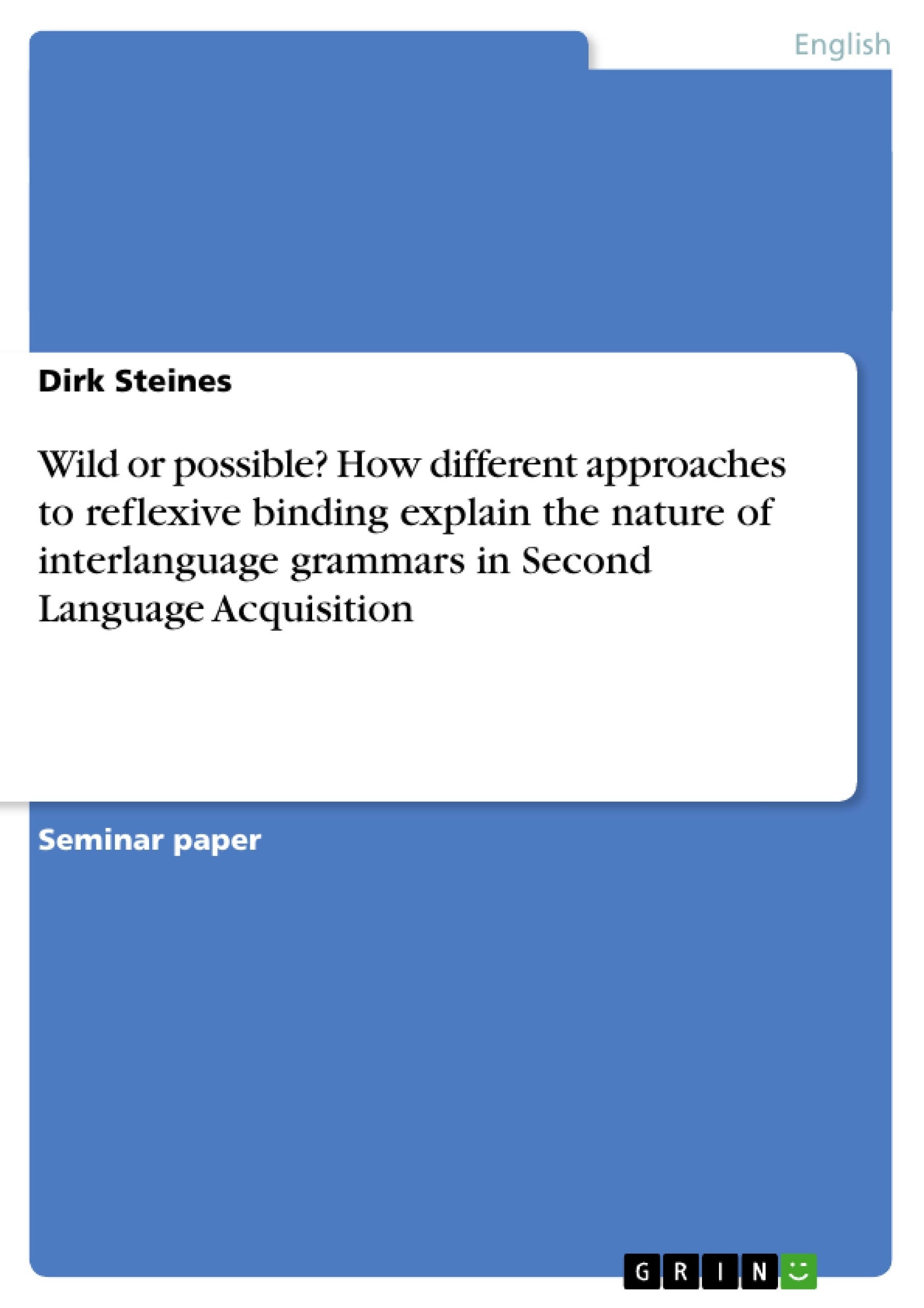Within the discourse of generative grammar it has been proposed that Universal Grammar (UG) can be seen as an innate structure that governs the course of learning a language. The domain of UG is often also referred to as the “principles and parameters framework”. While principles can be seen as a set of rules (e.g. the linearity of language) that are applicable for all natural languages, certain parameters make up and have to be set according to different languages. As there is not much disagreement on the role of UG for the acquisition of a first language (L1), many researchers have discussed the question if and how UG constrains second language acquisition (L2A).
A large amount of research has been conducted within the field of the acquisition of reflexives in L2. Earlier approaches explained the acquisition of reflexives in L2A as a resetting of the Governing Category Parameter (GCP). Other approaches accounted the cross-linguistic variation in interpreting domain and orientation of anaphors to different categories of anaphors, namely X0 or head reflexives and XP or phrasal reflexives. It was then hypothesized that interpretation of these reflexives in L2A can either be the consequence of movement in Logical Form or a result of parameter settings regarding the agreement (AGR) parameter resulting in a relativized SUBJECT.
The aim of this paper is to give a short overview of the above mentioned approaches on the domain of reflexivity acquisition by presenting one study for each approach. The results of the different studies will be discussed with emphasis to the question to what extent they show evidence for the non-/availability of UG in L2A. Based on this, a suggestion is stated, that the relativized SUBJECT approach is most sufficient to explain UG-availability in terms of the Full Transfer/Full Access Hypothesis.
Inhaltsverzeichnis (Table of Contents)
- Introduction
- Three approaches to reflexive binding
- The Multivalued Governing Category Parameter Approach
- A Study: Makiko Hirakawa 1990
- The Movement in Logical Form Approach
- A study: Christie and Lantolf 1998
- A Study: Bennett 1994
- The Relativized SUBJECT Approach
- Discussion
- Conclusion
- References
Zielsetzung und Themenschwerpunkte (Objectives and Key Themes)
This paper aims to provide a brief overview of different approaches to reflexive binding in Second Language Acquisition (L2A), with a focus on how they explain the nature of interlanguage grammars. The paper analyzes these approaches through the lens of Universal Grammar (UG) and its influence on L2A.
- The role of Universal Grammar (UG) in L2A
- Different approaches to reflexive binding in L2A
- The Governing Category Parameter (GCP) and its application to L2A
- The interplay between L1 and L2 grammars in reflexive acquisition
- The Relativized SUBJECT approach and its implications for UG availability in L2A
Zusammenfassung der Kapitel (Chapter Summaries)
- Introduction: This chapter introduces the concept of Universal Grammar (UG) and its relevance to language acquisition. It then explores the debate on whether and how UG influences second language acquisition (L2A) and highlights the specific focus on reflexive acquisition in L2A.
- Three Approaches to Reflexive Binding: This chapter delves into three different approaches to understanding reflexive binding in L2A: the Multivalued Governing Category Parameter Approach, the Movement in Logical Form Approach, and the Relativized SUBJECT Approach. Each approach is discussed in detail, providing an overview of their key principles and how they explain reflexive acquisition.
- The Multivalued Governing Category Parameter Approach: This section presents the Governing Category Parameter (GCP) as proposed by Wexler and Manzini (1987) and discusses its application in L2A research. It then provides a detailed explanation of a study by Makiko Hirakawa (1990) investigating the acquisition of English reflexives by Japanese learners. The study examines whether L2 learners can successfully reset the GCP to match the target language (English).
- The Movement in Logical Form Approach: This section presents the Movement in Logical Form Approach and discusses how it explains reflexive acquisition in L2A. It then offers summaries of two studies: Christie and Lantolf (1998) and Bennett (1994), which explore the acquisition of reflexives through the lens of this approach.
- The Relativized SUBJECT Approach: This section introduces the Relativized SUBJECT approach, focusing on the role of agreement (AGR) parameters in determining the interpretation of reflexives. It provides a conceptual overview of this approach without presenting specific study details.
Schlüsselwörter (Keywords)
Key terms and concepts addressed in this paper include Universal Grammar (UG), second language acquisition (L2A), reflexive binding, Governing Category Parameter (GCP), interlanguage grammars, the Relativized SUBJECT approach, and the Full Transfer/Full Access Hypothesis. These terms highlight the focus on understanding how learners acquire grammatical structures and how different approaches explain the role of UG in L2A.
- Quote paper
- Diplom Sportwissenschaftler Dirk Steines (Author), 2006, Wild or possible? How different approaches to reflexive binding explain the nature of interlanguage grammars in Second Language Acquisition, Munich, GRIN Verlag, https://www.grin.com/document/74501



